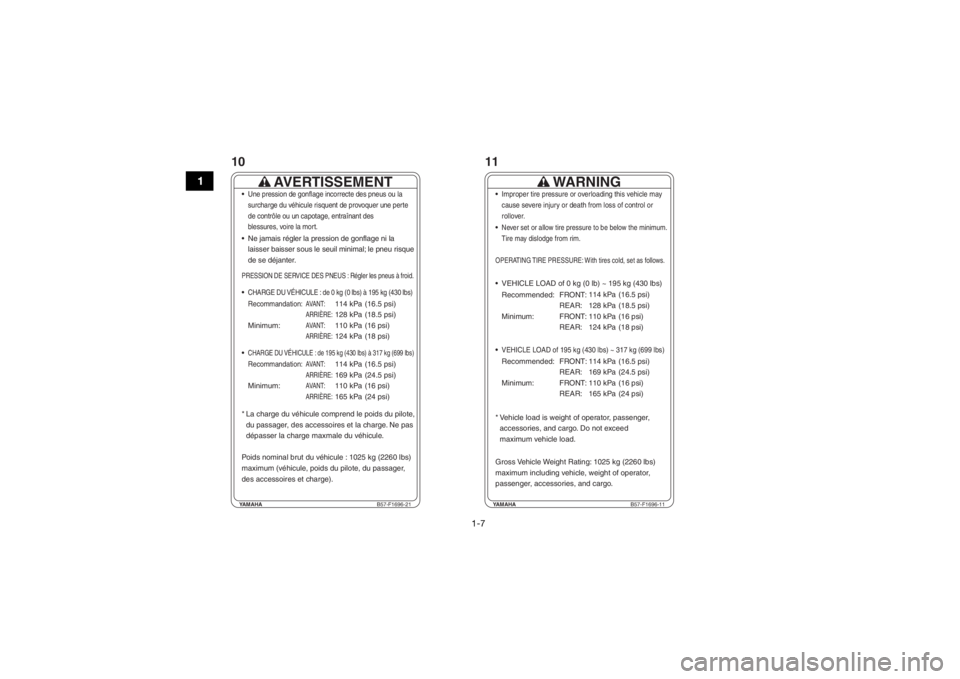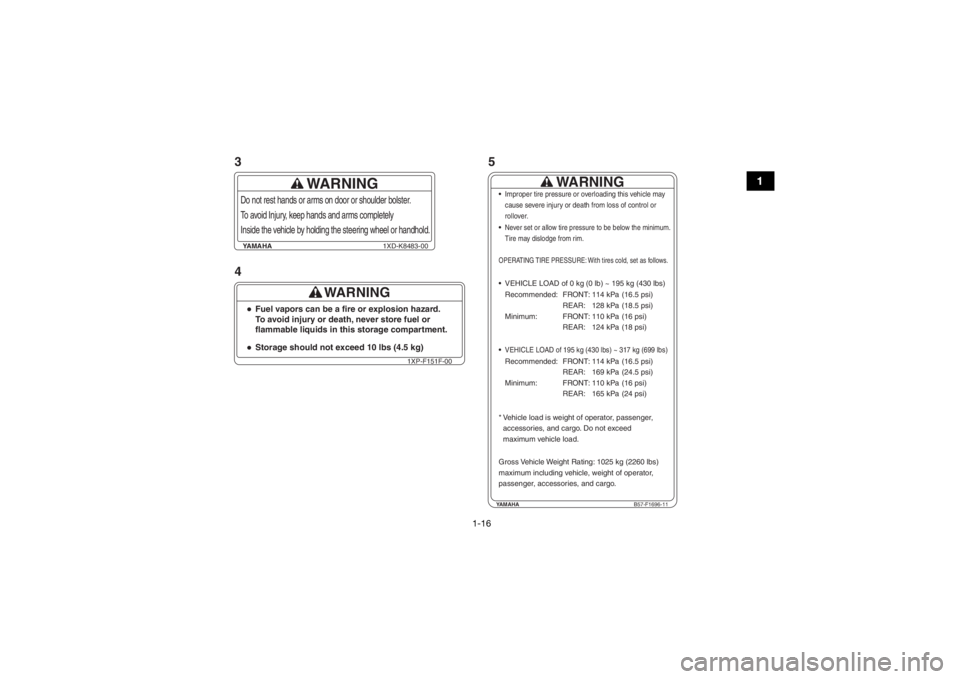tire pressure YAMAHA YXZ1000R 2018 Owners Manual
[x] Cancel search | Manufacturer: YAMAHA, Model Year: 2018, Model line: YXZ1000R, Model: YAMAHA YXZ1000R 2018Pages: 224, PDF Size: 5.68 MB
Page 16 of 224

1-7
1
YAMAHAB57-F1696-21
AVERTISSEMENT
Une pression de gonflage incorrecte des pneus ou la
s u rcharge du v éhicu le risqu ent de pro voqu er u ne perte
de contrôle o u u n capotage, entraînant des
b lessu res, v oire la mort.Ne jamais régler la pression de gonflage ni la
laisser b aisser so us le seu il minimal; le pneu risque
de se déjanter.
CHARGE DU VÉHICULE : de 0 kg (0 lb s) à 195 kg (430 lbs)Recommandation:
AVANT:
ARRIÈRE:
Minim um:
AVANT:
ARRIÈRE:
114 kPa
128 kPa
110 kPa
124 kPa (16.5 psi)
(18.5 psi)
(16 psi)
(18 psi)
CHARGE DU VÉHICULE : de 195 kg (430 lb s) à 317 kg (699 lbs)Recommandation:
AVANT:
ARRIÈRE:
Minim um:
AVANT:
ARRIÈRE:
114 kPa
169 kPa (16.5 psi)
(24.5 psi)
(16 psi)
(24 psi)
110 kPa
165 kPa
* La charge du v éhicule comprend le poids d u pilote,
du passager, des accessoires et la charge. Ne pas
dépasser la charge maxmale du v éhicule.
Poids nominal br ut du véhicule : 1025 kg (2260 l bs)
maxim um (véhicule, poids du pilote, du passager,
des accessoires et charge).
PRESSION DE SERVICE DES PN EUS : Régler les pneu s à froid.
YAMAHA B57-F1696-11
WARNING
Improper tire pressure or overloading this v ehicle may
cause se vere injury or death from loss of control or
rollo ver.Ne ver set or allo w tire pressure to be belo w the minimum.
Tire may dislodge from rim. VEHICLE LOAD of 0 kg (0 l b) ~ 195 kg (430 lbs)
Recommended: FRO NT:
REAR:
Minim um: FRONT:
REAR:114 kPa
128 kPa
110 kPa
124 kPa
VEHICLE LOAD of 195 kg (430 l bs) ~ 317 kg (699 lbs)Recommended: FRONT:
REAR:
Minim um: FRONT:
REAR:114 kPa
169 kPa
110 kPa
165 kPa (16.5 psi)
(18.5 psi)
(16 psi)
(18 psi)
(16.5 psi)
(24.5 psi)
(16 psi)
(24 psi)
* V ehicle load is w eight of operator, passenger,
accessories, and cargo. Do not exceed
maxim um vehicle load.
Gross Vehicle Weight Rating: 1025 kg (2260 l bs)
maxim um including v ehicle, weight of operator,
passenger, accessories, and cargo.OPERATING TIRE PRESSURE: With tires cold, set as follows.11
10
UB0F7AE0.book Page 7 Monday, November 6, 2017 2:30 PM
Page 25 of 224

1-16
1
YAMAHA1XD-K8483-00
WARNING
Do not rest hands or arms on door or shoulder bolster.
To a void Inju ry, keep hands and arms completely
Inside the v ehicle by holding the steering wheel or handhold.
WARNING
Stora ge should not exceed 10 lbs (4.5 kg)Fuel vapors can be a fire or explosion hazard.
To avoid injury or death, never store fuel or
flammable liquids in this stora ge compartment.
1XP-F151F-00
YAMAHA B57-F1696-11
WARNING
Improper tire pressure or overloading this v ehicle may
cause se vere injury or death from loss of control or
rollo ver.Ne ver set or allo w tire pressure to be belo w the minimum.
Tire may dislodge from rim. VEHICLE LOAD of 0 kg (0 l b) ~ 195 kg (430 lbs)
Recommended: FRO NT:
REAR:
Minim um: FRONT:
REAR:114 kPa
128 kPa
110 kPa
124 kPa
VEHICLE LOAD of 195 kg (430 l bs) ~ 317 kg (699 lbs)Recommended: FRONT:
REAR:
Minim um: FRONT:
REAR:114 kPa
169 kPa
110 kPa
165 kPa (16.5 psi)
(18.5 psi)
(16 psi)
(18 psi)
(16.5 psi)
(24.5 psi)
(16 psi)
(24 psi)
* V ehicle load is w eight of operator, passenger,
accessories, and cargo. Do not exceed
maxim um vehicle load.
Gross Vehicle Weight Rating: 1025 kg (2260 l bs)
maxim um including v ehicle, weight of operator,
passenger, accessories, and cargo.OPERATING TIRE PRESSURE: With tires cold, set as follows.
3
4 5
UB0F7AE0.book Page 16 Monday, November 6, 2017 2:30 PM
Page 30 of 224

2-3
2
• Do not drive or ride as passenger after using drugs or alcohol.
Prepare your vehicle
Perform the pre-operation checks each time you use the vehicle to make sure it is in safe oper-
ating condition. Failure to inspect or maintain th e vehicle properly increases the possibility of an
accident or equipment damage. See page 5-1 for a list of pre-operation checks.
Prepare your load
Carrying heavy or over-sized loads can affect hand ling, stability, and cause the risk of overturns
or other accidents.
Read “Loading” on page 6-12 before loading the cargo bed.
Do not overload the vehicle or cargo bed.
Refer to the labels on the vehicle for specific loading limits and recommended tire air pressure.
Keep heavier objects and the load in general cent ered side to side, and as low and as far for-
ward in the cargo bed as possible.
Secure cargo so that it will not shift – a loose load could change handling unexpectedly or be
thrown forward and strike occupants.
This vehicle is not designed to tow or pull objects. Towing a trailer or pulling another vehicle or
other object will affect handling, stability, an d increase the risk of overturns and accidents.
Towing or pulling can also cause frame and vehicle damage.
UB0F7AE0.book Page 3 Monday, November 6, 2017 2:30 PM
Page 96 of 224

5-2
5
Drivetrain• Check front differential, transmission case, and rear final
gear for leakage. 5-6, 5-6, 5-6, 8-27,
8-29, 8-32
Coolant • Check coolant level in reservoir.
• Fill with coolant if necessary. 5-6, 8-34
Accelerator pedal • Check free play and for proper operation. 5-6
Seat belts • Check for proper operation and belt wear. 5-7
Passenger handhold • Check for stability and proper fastening. 5-7, 7-8
Steering • Check for proper operation. 5-7
Drive select lever and
shift paddles • Check for proper operation. 5-7
YCC-S clutch • Check operation.
• Check fluid level in reservoir.
• If necessary, add specified brake fluid to specified level.
• Check hydraulic system for leakage.
5-8
Fittings and fasteners • Check all fittings and fasteners. 5-8
Instruments, lights and
switches • Check for proper operation. 3-3, 4-2, 5-8, 8-65,
8-65
Wheels and tires • Check tire pressure and for wear and damage. 5-8, 8-55, 8-57
Axle boots • Check for damage. 8-36
ITEM ROUTINE PAGEUB0F7AE0.book Page 2 Monday, November 6, 2017 2:30 PM
Page 102 of 224

5-8
5
EBU36672YCC-S clutchCheck the YCC-S clutch fluid level and cor-
rect if necessary. (See page 8-46.)
Check the operation of the drive select lever
and shift paddles at the start of each drive.TIPIf the YCC-S clutch fluid level was low, be
sure to check the clutch system for leak-
age.
If any leakage is found, or if shifting is not
smooth, have a Yamaha dealer service the
vehicle. EBU35700Fittings and fastenersAlways check the tightness of chassis and
wheel fittings and fasteners before starting
off. Take the vehicle to a Yamaha dealer or re-
fer to the Service Manual for correct tighten-
ing torque.
EBU31840Instruments, lights and switchesCheck that all instruments, lights and switch-
es are working properly. Correct if necessary.EBU31851Control cablesWhen driving in cold weather, always make
sure all control cables work smoothly before
starting off. WARNING! Control cables can
freeze in cold weather and you could be
unable to control the vehicle.
[EWB03280]
EBU35332
TiresCheck tire pressure regularly to make sure it
is at the recommended specifications. Also
check for wear and damage.
Tire pressure
Use the tire pressure gauge to check and ad-
just tire pressures when the tires are cold. Tire
pressures must be equal on both sides.
WARNING! Operation of this vehicle with improper tire pressure may cause severe
UB0F7AE0.book Page 8 Monday, November 6, 2017 2:30 PM
Page 103 of 224
![YAMAHA YXZ1000R 2018 Owners Manual 5-9
5
injury or death from loss of control or roll-
over. Tire pressure below the minimum
specified could also cause the tire to dis-
lodge from the rim under severe driving
conditions.
[EWB03960]
Op YAMAHA YXZ1000R 2018 Owners Manual 5-9
5
injury or death from loss of control or roll-
over. Tire pressure below the minimum
specified could also cause the tire to dis-
lodge from the rim under severe driving
conditions.
[EWB03960]
Op](/img/51/53889/w960_53889-102.png)
5-9
5
injury or death from loss of control or roll-
over. Tire pressure below the minimum
specified could also cause the tire to dis-
lodge from the rim under severe driving
conditions.
[EWB03960]
Operating tire pressure:Vehicle load of 0 - 195 kg (0 - 430 lb) Front: (Recommended)114.0 kPa (1.140 kgf/cm², 16.5 psi)
Rear: (Recommended) 128.0 kPa (1.280 kgf/cm², 18.5 psi)
Front: (Minimum) 110.0 kPa (1.100 kgf/cm², 16.0 psi)
Rear: (Minimum) 124.0 kPa (1.240 kgf/cm², 18.0 psi)
Vehicle load of 195 kg - maximum (430 lb -
maximum) Front: (Recommended)114.0 kPa (1.140 kgf/cm², 16.5 psi)
Rear: (Recommended) 169.0 kPa (1.690 kgf/cm², 24.5 psi)
Front: (Minimum) 110.0 kPa (1.100 kgf/cm², 16.0 psi)
Rear: (Minimum) 165.0 kPa (1.650 kgf/cm², 24.0 psi)
Maximum vehicle load*: 317.0 kg (699 lb)
* Total weight of operator, passenger, acces- sories, and cargo
UB0F7AE0.book Page 9 Monday, November 6, 2017 2:30 PM
Page 104 of 224

5-10
5
The tire pressure gauge is included as stan-
dard equipment. Make two measurements of
the tire pressure and use the second reading.
Dust or dirt in the gauge could cause the first
reading to be incorrect.
Tire wear limit
When the tire groove decreases to 3 mm
(0.12 in) due to wear, replace the tire.1. Tire pressure gauge
1
1. Tire wear limit
1
UB0F7AE0.book Page 10 Monday, November 6, 2017 2:30 PM
Page 134 of 224
![YAMAHA YXZ1000R 2018 Owners Manual 7-17
7
TIPYou may need to turn the steering wheel left
and right to help the differential lock into pla-
ce. 3. Stop the engine (turn the key to “ ”[off]).
4. With the brake pedal still being appl YAMAHA YXZ1000R 2018 Owners Manual 7-17
7
TIPYou may need to turn the steering wheel left
and right to help the differential lock into pla-
ce. 3. Stop the engine (turn the key to “ ”[off]).
4. With the brake pedal still being appl](/img/51/53889/w960_53889-133.png)
7-17
7
TIPYou may need to turn the steering wheel left
and right to help the differential lock into pla-
ce. 3. Stop the engine (turn the key to “ ”[off]).
4. With the brake pedal still being applied, set the parking brake.
5. Finally, get out of the vehicle and block
the front and rear wheels with rocks or
other objects.
Loading
Be aware that vehicle load includes the total
combined weight of the operator, passenger,
any installed accessories, and any luggage or
cargo brought on board or stored in the cargo
bed. Make sure that the gross vehicle weight
(vehicle load plus weight of the vehicle itself)
never exceeds 1025 kg (2260 lb). Vehicle loading can affect handling as well as
the recommended tire pressure. (See pages
6-12, 5-8.)
EBU36681Operation on different surfaces and
terrainsGo slowly and proceed with caution when op-
erating on an unfamiliar surface or terrain.
This vehicle may handle differently in certain
types of terrains or on certain surfaces. You
may come upon hidden rocks, bumps, or
holes without enough time to react. To avoid
loss of control or rollover, always be alert to
changing surfaces or terrain when operating
the vehicle.
Your Yamaha YXZ1000R has higher ground
clearance and other features to handle rug-
ged terrain, and as a result, can overturn in
situations where some vehicles may not.
Abrupt maneuvers or aggressive driving can
cause loss of control, including rollovers –
UB0F7AE0.book Page 17 Monday, November 6, 2017 2:30 PM
Page 141 of 224

8-2
8
EBU33561Owner’s Manual and tool kitYou are recommended to put this manual in
the vinyl bag and always carry it in the glove
compartment as shown. Put the tool kit and
tire pressure gauge under the passenger
seat.The maintenance information included in this
manual is intended to provide you, the owner,
with the necessary information for completing
your own preventive maintenance and minor
repairs.
The tools provided in the tool kit are sufficient
for this purpose, and should be kept on the
vehicle in case of emergency repairs.
Other tools and equipment are required for
certain service items. If you do not have a
torque wrench available during a service op-1. Owner’s Manual
1
1. Tool kit
2. Tire pressure gauge
1
2
UB0F7AE0.book Page 2 Monday, November 6, 2017 2:30 PM
Page 215 of 224

10-4
10
Loading:Maximum loading limit:317.0 kg (699 lb)
(Total weight of operator, passenger, cargo, and
accessories)Tire air pressure (measured on cold tires):Recommended: Vehicle load:0 - 195 kg (0 - 430 lb)
Front: 114.0 kPa (1.140 kgf/cm², 16.5 psi)
Rear:
128.0 kPa (1.280 kgf/cm², 18.5 psi)
Vehicle load: 195 kg - maximum (430 lb - maximum)
Front: 114.0 kPa (1.140 kgf/cm², 16.5 psi)
Rear:
169.0 kPa (1.690 kgf/cm², 24.5 psi)
Minimum: Vehicle load:
0 - 195 kg (0 - 430 lb)
Front: 110.0 kPa (1.100 kgf/cm², 16.0 psi)
Rear: 124.0 kPa (1.240 kgf/cm², 18.0 psi)
Vehicle load:
195 kg - maximum (430 lb - maximum)
Front: 110.0 kPa (1.100 kgf/cm², 16.0 psi)
Rear: 165.0 kPa (1.650 kgf/cm², 24.0 psi)
Front wheel:Wheel type:Cast wheel
Rim size:
14 x 6.5ATRear wheel:Wheel type:Cast wheel
Rim size:
14 x 8.0ATFront brake:Type:Hydraulic disc brake
Specified brake fluid:
DOT 4Rear brake:Type:Hydraulic disc brake
Specified brake fluid:
DOT 4Front suspension:Type:Double wishbone
Spring/shock absorber type:
Coil spring/gas-oil damper
Wheel travel: 410 mm (16.2 in)Rear suspension:Type:
Double wishbone
UB0F7AE0.book Page 4 Monday, November 6, 2017 2:30 PM